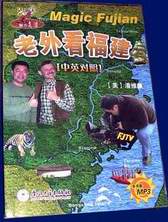![]() Click
to
Access
Click
to
Access
OUTSIDE China
![]() Click
to Access
Click
to Access
INSIDE
China ![]()
TRAVEL LINKS
![]() Xiamen
Xiamen
![]() Gulangyu
Gulangyu
![]() Jimei
Jimei
![]() Tong'an
Tong'an
![]() Jinmen
Jinmen
![]() Zhangzhou
Zhangzhou
![]() Quanzhou
Quanzhou
![]() Wuyi
Wuyi
![]() #1Fujian
Sites!
#1Fujian
Sites!
![]() Fujian
Foto Album
Fujian
Foto Album
![]() Books
on Fujian
Books
on Fujian
![]() Readers'Letters
Readers'Letters
![]() Ningde
Ningde
![]() Zhouning
Zhouning
![]() Longyan
Longyan
![]() Sanming
Sanming
![]() Putian
Putian
![]() Bridges
Bridges
![]() Travel
Info,
Travel
Info,
![]() Hakka
Roundhouses
Hakka
Roundhouses
![]() Travel
Agents
Travel
Agents
MISC. LINKS
![]() Amoy
People!
Amoy
People! ![]()
![]() Darwin
Driving
Darwin
Driving ![]()
![]() Amoy
Tigers
Amoy
Tigers
![]() Chinese
Inventions
Chinese
Inventions
![]() Tibet
in 80 Days!
Tibet
in 80 Days!![]()
![]() Dethroned!
Dethroned!
![]()
![]() Misc.Writings
Misc.Writings
![]() Latest
News
Latest
News
![]() Lord
of Opium
Lord
of Opium
![]() Back
to Main Page
Back
to Main Page
![]() Order
Books
Order
Books![]() Xiamenguide
Forum
Xiamenguide
Forum 

Zhouning Zhouning
Photo Album
 Country
Roads Take Me Home—Please! A Chinese artist airily
informed me, “I never take highways. They bypass the real China."
I doubt the man has ever driven! I also enjoy country roads, but without
the new freeways (which really should be called not-so-freeways
because of the killer tolls), not even a cat
would have enough lives to see all of Fujian’s convoluted topography.
Besides, you show me a good, flat country road anywhere in China and I’ll
show you a few hundred farmers using 2/3 of the highway to dry grain.
....
Country
Roads Take Me Home—Please! A Chinese artist airily
informed me, “I never take highways. They bypass the real China."
I doubt the man has ever driven! I also enjoy country roads, but without
the new freeways (which really should be called not-so-freeways
because of the killer tolls), not even a cat
would have enough lives to see all of Fujian’s convoluted topography.
Besides, you show me a good, flat country road anywhere in China and I’ll
show you a few hundred farmers using 2/3 of the highway to dry grain.
....
Until the 90s, roads
were so poorly reinforced that landslide followed even a minor squall
(or a major flock of birds with full bladders). Land is sliding less nowadays
thanks to better roads 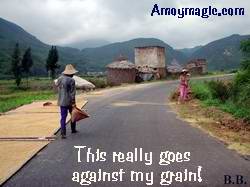 and
armies of maintenance crews in International Orange safety vests.
and
armies of maintenance crews in International Orange safety vests.
Back to Top
Victoriasian
Architecture
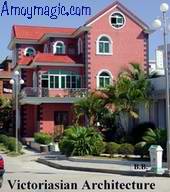 Villages
have traditional Minnan homes of granite, with flat roofs and verandas
lined with potted bougainvillea, azalea, hibiscus, and pepper plants.
But the newly rich boast magnificent 3- and 4-story homes with towers
and turrets galore. Some “Chinese Victorian” homes (Victoriasian?)
have a distinct Dr. Seuss flavor, and are clad in tiles of every color,
from classic Chinese blues and greens to pastel yellows, reds and pinks.
But unlike traditional homes, with land at a premium the new homes are
going up, not out (some families have 7 story homes!).
Villages
have traditional Minnan homes of granite, with flat roofs and verandas
lined with potted bougainvillea, azalea, hibiscus, and pepper plants.
But the newly rich boast magnificent 3- and 4-story homes with towers
and turrets galore. Some “Chinese Victorian” homes (Victoriasian?)
have a distinct Dr. Seuss flavor, and are clad in tiles of every color,
from classic Chinese blues and greens to pastel yellows, reds and pinks.
But unlike traditional homes, with land at a premium the new homes are
going up, not out (some families have 7 story homes!).
Back to Top 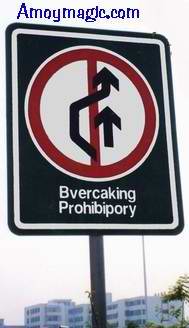 Signs
Of the Times
China’s unique English road signs help keep boredom at bay. Far
too often, signs warn, “Toll 500 meters ahead. Run Slowly Please.”
I guess they even charge joggers. But my favorite is the “Bvercaking
Prohibipory”sign on Guangzhou’s Shantou-Shenzhen Expressway.
It means “No passing” (“Overtaking Prohibited”).
Signs
Of the Times
China’s unique English road signs help keep boredom at bay. Far
too often, signs warn, “Toll 500 meters ahead. Run Slowly Please.”
I guess they even charge joggers. But my favorite is the “Bvercaking
Prohibipory”sign on Guangzhou’s Shantou-Shenzhen Expressway.
It means “No passing” (“Overtaking Prohibited”).
The same speed limit sign may read: 30 kph, 40 kph, 50 kph, 60 kph, or
70kph—five speeds for five varieties of vehicles, and all five species
simultaneously jostling along one or two lanes.
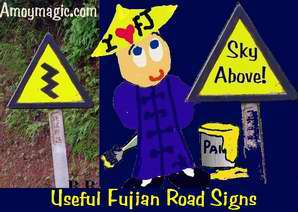
“Curve Ahead” signs can really
throw you for a curve . In vertical Fujian, which has neither flat land
nor straight roads, they are about as informative as “Sky Above”
or “Ground Below.”
Fuzzy
Dice & Disney
Americans have decorated their cars with everything from fuzzy dice and
dingleballs in the 50s to stuffed animals today. For Chinese, however,
status is a pair of gaudy red and gold plastic tissue boxes, and embroidered
throw cushions piled high in the rear window—maybe to show they
have a cushy job. The epitome is a row of plush Snow White and the Seven
Dwarfs dangling above the pillows and tissue boxes.
Backseat
Buddhas Chinese, like laowai, have fetishes to ward off accidents.
Catholics may count on St. Christopher medals, but Chinese increasingly
swear by color photos of Chairman Mao, who is thought to be better than
Buddha at preventing car crunches. As one taxi driver informed me, “Buddha
never drove.”
 Fungus
Among Us A field of peasants in pointy hats, bending over their
rice, reminded me of an odd species of mushroom. Closer observation revealed
that some peasants did move, but maybe mushrooms move as well. Evolutionists
say people evolved from fungi, which are closer to animals than they are
to plants. That may explain why some of us are such fun guys.
Fungus
Among Us A field of peasants in pointy hats, bending over their
rice, reminded me of an odd species of mushroom. Closer observation revealed
that some peasants did move, but maybe mushrooms move as well. Evolutionists
say people evolved from fungi, which are closer to animals than they are
to plants. That may explain why some of us are such fun guys.
Back to Top

For Whom the Road Tolls
Stylized black birds adorn the entrance to “Lightning Strikes Rock”
tunnel, just south of Fuzhou. Given the high tolls, they’re probably
buzzards, because tolls are everywhere on Fujian's "not-so-free-way."
But five minutes off the not-so-freeway I was mired in a Fuzhou traffic
jam created by road construction and complicated by a road emperor, hand
upon his horn, forging down the wrong lane. Already I yearned nostalgically
for the pricey but peaceful toll road! From now on, my motto is, “Bu
Yao Jin! Better the buzzard!”
Back to Top

Gates Given the Chinese’ love for great walls, it’s no wonder they love great gates and arches. And the bigger and more ornate the better. The most extreme gate may be the Napoleonic monstrosity at Dongshan Island’s 10 “Billion Dollar Village.” But my favorite gate is a Ningde village’s humble arch of two bamboo strips, from which dangles a piece of wood on which the name has been daubed in graceful strokes. No brag, just fact.
A
Very Grave Site
Tucked into a lonely valley just south of the Luoyan exit was a modern
cemetery—rare now that China encourages cremation. With a larger
population of dead folk than any nation on earth, it’s hard to find
a propitious place to plant extinguished ancestors. In 1912, Rev. Pitcher
wrote:
“China is one big graveyard, you can never get away from the
graves. They are in the dooryards, on the hilltops, along the highways
and hedges, everywhere. Look where you will, rarely will your vision be
unobstructed by a tomb of some kind.”
Wind
and Water A
Fujianese solemnly informed me that 72 bright spots on a NASA photograph
of China turned out to be Han Dynasty tombs chosen because of their excellent
fengshui. “Even modern science proves fengshui!” she enthused.
Chinese often invest vast sums in fengshui (“wind and water”),
because a propitious location for tombs, homes, even office buildings,
is an investment that yields automatic peace and prosperity.
Fengshui is methodical and mechanical, depending not on the good or ill
will of the deceased but upon where they are planted, and how...
 Gone
to Pot Since
some folk don’t give decent warning before dying, the first burial
site is often hastily selected. If months or years down the road the family
encounters misfortunes, or even lack of good fortune, they assume the
fengshui ‘failed,’ dig up the bones, and place them in an
earthen jar under a rock or tree until they can be replanted in a more
strategic location—in theory. In practice, the jars often become
the eternal resting place for folks like the bony inhabitants of clay
pots on the hill by our apartment. But on the bright side, if earthen
architecture is comforting for the living, why not a clay pot for those
who are not?
Gone
to Pot Since
some folk don’t give decent warning before dying, the first burial
site is often hastily selected. If months or years down the road the family
encounters misfortunes, or even lack of good fortune, they assume the
fengshui ‘failed,’ dig up the bones, and place them in an
earthen jar under a rock or tree until they can be replanted in a more
strategic location—in theory. In practice, the jars often become
the eternal resting place for folks like the bony inhabitants of clay
pots on the hill by our apartment. But on the bright side, if earthen
architecture is comforting for the living, why not a clay pot for those
who are not?
I’m sure my own demise will not be a jarring experience if Susan
Marie simply stores my ashes away in a convenient coffee jar. But not
decaffeinated.
Back to Top
Ningde--a Favorite Corner of Fujian
Remote Ningde, home of the She minority, turned out to be one of my favorite
corners of Fujian. Ningde boasts the Nine Dragon Falls (they really do
have a thing about “nine”), China’s largest waterfall
complex, as well as the otherworldly Taimu Mountain, the fine beaches
of Xiapu, and the ‘Walk on Water’ lake of baishuiyang, with
its mandarin ducks and rhesus monkeys. But the #1 attraction is the people,
and with 3.14 million of them, you won’t escape Ningde without making
some friends for life.
Birthplace
of South China Civilization?
Ningde has fully 1/3 of Fujian’s coastline (878 km!) and 344 islands
and islets. Sandu’ao, the world’s deepest ice-free harbor,
was Fujian’s center of trade and culture, and home to businesses
from a dozen nations until Japanese bombers twice razed the place to the
ground in the 1930s.
Jiaocheng District’s Huotong Mountain is touted as the birthplace
of south China civilization, and the Ming Emperor Yongle designated it
“Number One Mountain Under Heaven.”
Wenma County was established in 282 A.D., and quickly made a name for
itself with such luminaries as Xue Lingzhi (683-756), Fujian’s first
Jinshi (successful candidate in ancient China’s highest imperial
examinations), the Song Dynasty poet Lu You, and the philosopher Zhu Xi.
Japanese revered Ningde almost as much as the Chinese because it was here
that Kukai, founder of Esoteric Japanese Buddhism, was rescued from a
shipwreck when he arrived in China seeking the Buddhist scriptures.
She
Minority Village
An article on Ningde’s “primitive folk customs” described
the She’s unique bamboo architecture, colorful costumes, dances,
and antiphonal singing. Alas… I never saw any of this! The only
photos I have of She costumes were loaned to me by Zhu Qing Fu.
Most She have been Sinocized, thanks to well-meaning attempts to deliver
them from dire poverty. Traditional She bamboo architecture is vanishing,
and the time and expense of traditional costume is justified only on special
holidays—if then. My only hope the “Model She Minority Village.”
 "Model
She Minority Village" A Ningde brochure claims everyone from
China’s Premier to “Friends from Home and Abroad” love
Ningde’s mock She Village. I wasn’t so impressed. The bamboo
lodges and bridges were attractive, but the attendants lounged about lazily,
showing signs of life only when I got out my camera. “No photos!”
Eventually a youth started unlocking the brass She padlocks, but the boss
rushed up, blessed him out, told us there was nothing to see, and then
demanded we buy tickets.
"Model
She Minority Village" A Ningde brochure claims everyone from
China’s Premier to “Friends from Home and Abroad” love
Ningde’s mock She Village. I wasn’t so impressed. The bamboo
lodges and bridges were attractive, but the attendants lounged about lazily,
showing signs of life only when I got out my camera. “No photos!”
Eventually a youth started unlocking the brass She padlocks, but the boss
rushed up, blessed him out, told us there was nothing to see, and then
demanded we buy tickets.
“Why buy tickets if there is nothing to see?” I asked. And
so I wouldn’t come away empty handed, I quickly took his photo,
and put it to good use--as a dart board!
Just past the mock She village at the end of the road, on the right, was
a genuine She house. And about the only way to catch She in native costume
is to visit on the big March 3rd She festival.
Ahhh! But Ningde’s seafood more than made up for the She debacle!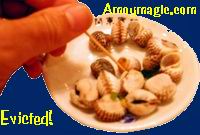
Sea
Slugs and Blood Snails
Given Ningde’s endless coastline, it’s no wonder seafood is
a staple. An official said that Ningde cuisine has such variety that it
takes at least 3 days to savor even the most common tastes, aromas, and
colors.
We feasted on winter melon soup and sea slugs, and my hosts explained
why the fish’s head and tail are reserved for honored guests. And
as always I explained I have no honor and was quite happy for them to
feast on the fish lips, gills, eyeballs and brains. No lips, just chips—with
some catsup.
My companions enthusiastically evicted hapless snails from their shells
with deftly wielded toothpicks. Bright blood gushed forth, and my hosts
gushed, “It’s an art! Cook too long and the blood dries up;
not long enough and you can’t open them… And our snails are
‘pearl’ snails—the perfect size. Lots of flesh, lots
of blood. Too bad that fakes from other places are giving Er Du a bad
name.”
After bloody snails came fresh asparagus. A century ago, Chinese refused
to touch asparagus, which seems odd, since Chinese eat everything edible
and prescribe the rest as medicine.
The bamboo shoots were as tender as fruit, and an endless variety of dried
meats and veggies was followed by straw mushrooms and black mushrooms
and fungi (for evolutionists with cannibalistic bents ). My loved the
hotel specialty—a large, thin pancake made with onions, pumpkin
powder, eggs, lotus powder, shrimp, sweet potato powder, peanut chunks,
deng deng. Ningde folk also enjoy Fuzhou’s flat, round sesame breads
with holes in the middle, which 600 years ago were hung around soldiers’
necks on string so they could eat on the go. So Chinese even invented
fast food.
My hosts raved loudest and longest about the local vinegar, made from
sticky rice. “The older and more sour, the better!” they exclaimed.
But personally I’d go easy on the vinegar if I were them. In Chinese,
“Eating Vinegar” connotes a spouse’s unfaithfulness,
or something like that.
Dessert was Ningde Longyans (Dragon Eye Fruit). “Last of the season,
and the best!” I was told. But days later a Fuding official scoffed.
“They’re the best only because there’s nothing else
left that late in the year!”.....
Burst My Bubble Like many hotels
in China, the Mindong Hotel supplied bubble bath, even though the bathroom
had only a shower, no tub. Maybe you’re supposed to pour it on your
head and dance under the nozzle. After a hot bubble shower, I flicked
on the TV to find Richard Marx singing, “Right Here Waiting for
You.” I think it’s a song about queuing up in government offices.
Star Sports had a soccer game, and the local channel was nonstop commercials
touting lotions that guaranteed perfect, long black hair, creams that
bleached skin pure white overnight, and teas that guaranteed a weight
loss of 30 pounds in 30 days, with no expenditure of effort but a considerable
expenditure of cash. ....... In sum, the programming was enough to put
anyone to sleep.
My sweet dreams were dashed at dawn by an outlandish cacophony of honking
horns, bike bells, and the shouting of vendors and vendees from a nearby
veggie market. I jammed my wax earplugs so tightly they threatened to
come out my nose, but no respite, so I crawled out of bed, dressed, and
strolled through the hotel courtyard.
The distant hills were so lush they reminded me of Hawaii (as would the
beaches I saw later). But Hawaiians don’t wake the dead until at
least after lunch, and Ningde’s beauty was lost on me until I recorded
it in retrospect 12 hours later. My head and heart were beside themselves,
but as Americans say, “The way to a man’s heart is through
his stomach,” so I made a beeline for breakfast.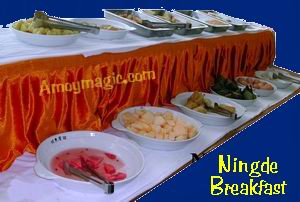
Chinese
Breakfast.
By noon, I can slurp sea slug soup, evict blood clams, and even enjoy
jellyfish and sea worms (with a dash of Tabasco ). But fresh out of bed
I don’t want congee and carp lips. I need toast, bacon, eggs and
coffee.
Mindong Hotel’s breakfast buffet did have eggs—or what was
left of them. I’m told that the gelatinous black and green “Century
Eggs” are pickled in horse urine, and I believe it. They smell like
ammonia. I just heard that women’s estrogen pills are made from
horse urine. Maybe they should just eat Chinese Century Eggs. (They’re
not bad when sliced and added to rice porridge, with peanuts and dried
minnows.)
My hostess noticed my distress and forever endeared herself to me by ordering
coffee. But it had at least four times more sugar than coffee (the only
way many Chinese can stomach it). I asked for black coffee and got a beverage
blacker than a black hole, with so much caffeine that I was fortified
and ready to tackle every creature laid out on the buffet table.
I feasted on steamed buns stuffed with veggies and assorted carcasses,
dried minnows (heads staring sadly at me), bitter melon, strips of lamb
stomach, sliced carrots and cucumbers, pig intestines, cookies and cakes,
watermelon, Hami melon from Xinjiang, and soft tofu in soy sauce. After
sampling half of the 30+ entrees, I was buzzing with caffeine and MSG,
and ready to take on Water World.
Water
World Sandu’ao
Island has been open to outside trade since the Tang Dynasty, but because
of its proximity to Taiwan, and the presence of the People’s Navy,
it is now off limits to us foreign devils. So it was a treat to be given
a tour of the island and the “fishing villages on the sea.”
TRAVEL
LINKS  Favorite
Fujian Sites
Favorite
Fujian Sites  Fujian
Foto Album
Fujian
Foto Album  Xiamen
Xiamen
 Gulangyu
Gulangyu
 Fujian
Guides
Fujian
Guides  Quanzhou
Quanzhou
 Zhangzhou
Zhangzhou
 Longyan
Longyan
 Wuyi
Mtn
Wuyi
Mtn  Ningde
Ningde
 Putian
Putian
 Sanming
Sanming
 Zhouning
Zhouning
 Taimu
Mtn.
Taimu
Mtn.  Roundhouses
Roundhouses
 Bridges
Bridges
 Jiangxi
Jiangxi
 Guilin
Guilin
 Order
Books
Order
Books
 Readers'
Letters
Readers'
Letters
Last Updated: May 2007
![]()
DAILY
LINKS
![]() FAQs
Questions?
FAQs
Questions?
![]() Real
Estate
Real
Estate
![]() Shopping
Shopping
![]() Maps
Maps
![]() Bookstores
Bookstores
![]() Trains
Trains
![]() Busses
Busses
![]() Car
Rental
Car
Rental
![]() Hotels
Hotels
![]() News
(CT)
News
(CT)
![]() Medical
& Dental
Medical
& Dental
![]() YMCA
Volunteer!
YMCA
Volunteer! ![]()
![]() XICF
Fellowship
XICF
Fellowship
![]() Churches
Churches
![]()
![]()
![]() Temples
Temples![]()
![]() Mosque
Mosque
![]() Expat
Groups
Expat
Groups
![]() Maids
Maids
![]() Phone
#s
Phone
#s
EDUCATION
![]() Xiamen
University
Xiamen
University
![]() XIS(Int'l
School)
XIS(Int'l
School)
![]() Study
Mandarin
Study
Mandarin
![]() CSP(China
Studies)
CSP(China
Studies)
![]() Library
Library
![]() Museums
Museums
![]() History
History
DINING
![]() Restaurants
Restaurants
![]() Asian
Asian
![]() Veggie
Veggie
![]() Junk
Food
Junk
Food
![]() Chinese
Chinese
![]() Italian
Italian
![]() International
International![]()
![]() Visas
4 aliens
Visas
4 aliens
RECREATION
![]() Massage!
Massage!
![]() Beaches
Beaches
![]() Fly
Kites
Fly
Kites
![]() Sports
Sports
![]() Boardwalk
Boardwalk
![]() Parks
Parks
![]() Pets
Pets
![]() Birdwatching
Birdwatching
![]() Kung
Fu
Kung
Fu ![]() Hiking
Hiking
![]() Music
Events
Music
Events
![]() Festival&Culture
Festival&Culture
![]() Humor&
Humor&![]() Fun
Fotos
Fun
Fotos![]()
BUSINESS
![]() Doing
Business
Doing
Business
![]() Jobs!(teach/work)
Jobs!(teach/work)
![]() Hire
Workers
Hire
Workers
![]() Foreign
Companies
Foreign
Companies
![]() CIFIT
(Trade Fair)
CIFIT
(Trade Fair)
![]() MTS(Translation)
MTS(Translation)
![]()
Back to Top






